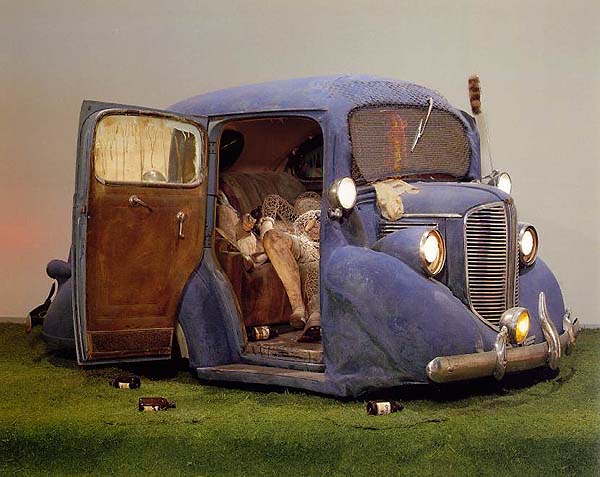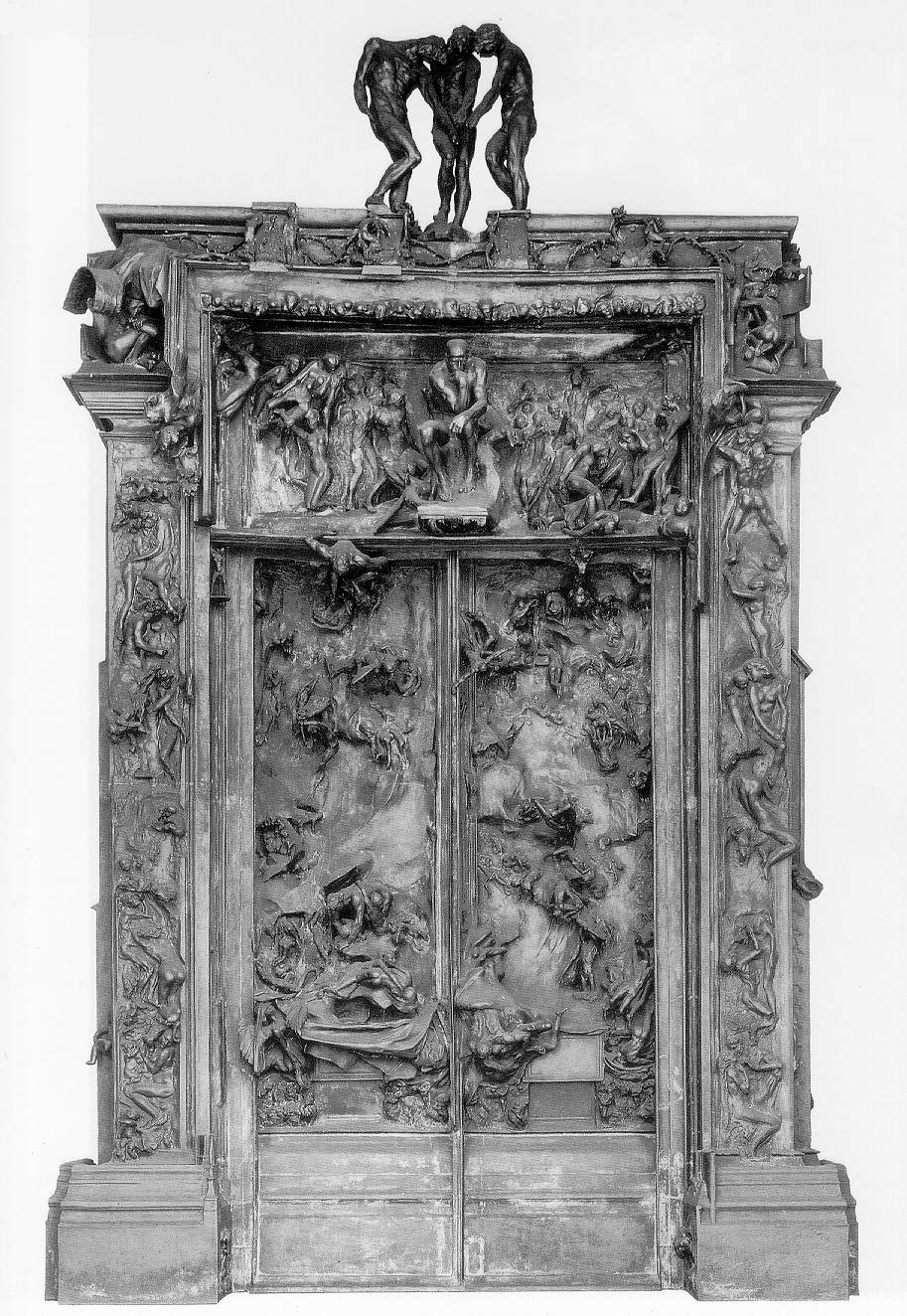Neither did Emma in the back seat.

But that was kinda the whole point.
Posted on 06/12/2005 6:08:39 PM PDT by vannrox
I wish Mr. Lombardo could have defined what he meant by modern art.
OTOH, I just leafed through the entire MOMA painting collection online without seeing much that I liked, and only a couple things I think are "great." Not much skill displayed, IMO.
It's not just what I see before me in the museum, I come to a conclusion about an artwork based on the three qualities the artist--and the artist alone--owns when he decides to take brush to canvas (or whatever means he is using to construct an artwork): that is to say, the concept, technique and execution.
Looking at an artwork, we don't necessarily know who or what the artists's muse was----although a still life, landscape, or a portrait hints at that; it's nice to feel the serenity such paintings inspire.
Now I would not necessarily admire Broken Kilometer by de Maria, but there is an inventiveness about the work that titillates one's fancy. It stimulates the mind, makes all kinds of questions come to the fore, mostly, "What in heaven's name gave the artist his inspiration?" And it surely makes the viewer laugh in its sheer uselesness. In that, it has some value.
The massive Guernica makes an impact just in the sheer size of the canvas Picasso chose to make his anti-war statement. Trying to dissect the abstractions created, Picasso was making an ugly subject more ugly.
Neither did Emma in the back seat.

But that was kinda the whole point.
The Picasso: your comment about the woman and child. There's a woman and child in that mess?
Obviously the picasso would never make it over the sofa
The statutes however are wonderful.
Of course, I don't think there's a work by Michelangelo that I don't just love.
You are absolutely right. I just choose different words: form and content. The content is the concept; the form is the technique and execution thereof. Or, as I say in a more down-to-earth manner, what the work looks like (form) and what it means (content). All are essential.
I'm glad your interest is piqued by the Broken Kilomter. I'm not sure he had a great sense of humor, but maybe I'm wrong. I think you may be more open-minded than I am.
Are you an artist?
Ed Kienholz has actually done some pretty intense works. They evoke a great deal of feelings, from nostalgia to horror, and they are often quite political. (Yeah, leftist politics.)


Kienholz State Hospital and Sollie. Both in the late 1960s, or thereabouts.
Both of these were built rooms in which you looked to see these lonely, depressed men. I saw them at a retrospective where one work, Roxy's was about a house of prostitution in New Orleans, a place where fathers took their young teen-age sons for their first experience. Very dreary, room-sized piece with the "women" characters as slot machines, etc. Some viewers had children with them; the exhibiton should have been rated PG-13 or R. Very intense. But that piece has stayed with me. He communicated what he wanted to. It was a good piece of art, as are all his pieces.
I tend to "enjoy" more positive pieces as a rule. But you don't forget a Kienholz.
The earlier one is far better. It looks like what it should be. The later one looks as if it's not quite done yet. As I mentioned in one of the earlier threads I really like Rodin (Hope I spelled that right) primarily because of his attention to detail. The guy did wonderful things with hands.
He also allows blobs of the bronze to stay on the pieces after casting (i.e. the blobs are not polished off). This is a bit like the painterly brushstrokes of van Gogh; it gives more emotional power to the pieces.


Rodin's Gates of Hell, Adam, Balzac Note how Adam's hands have changed for the triple ensemble at the top of the Gates of Hell. Also note the blobs on Balzac, especially on the bridge of his nose.
Finally, I think the swarming bodies on the main doors are a great image of the struggle of Hell.
The Voynich Manuscript! There's a great essay by Terrence McKenna about the Voynich in which he calls it "the perfect occult artifact; the book nobody can read" and as such, it can be anything we imagine it to be. Actually translating it (if indeed it's not just a very clever hoax) is likely to be a disappointment.
The first part was a real page turner, but I was disappointed with the ending.
That is a nice way of saying it. But, IMO, while the concept of Broken Kilometer *may* be clever, the artistic skill is not evident. The technique and execution might be sort of OK in terms of carpentry, but I can't see that from the picture.
That "Back Seat" thing is pretty cool, IMO.
My point is that while I contemplate all artworks in the light of the criteria, the three individual values are sometimes not all well-represented in a single work. One or two of the three may stand out more than the others.
In Broken Kilometer, the artist concentrates on neatness as the aesthetic---the work's neatness is a standout in its execution----neatness inspires serenity in the viewer. It is rather amusing to contemplate the artist dreaming up the concept. Maybe he's a runner, and gets through it by breaking up the mileage in sets as he runs, to accomplish his goals? Which might also have motivated his choice of materials---he might do his running on a boardwalk (grin).
Well this particular weekend happend to be during the Rodin exhibit where they had the "Gates of Hell" assembled. I don't remember if it was the first time or the first time in a long time but it was an awesome exhibition. Opened with a sculpture garden out in the foyer of pieces from his time frame. Don't remember any of the artists but the sculpture was wonderful (I do like sculpture). The exhibit included his hand studies and sketches and most of his works. (All the pieces to the gates, Burghers of Calais, The Kiss (perhaps my favorite of all time) and lots more. I spent the better part of the day there.
Any of those pieces would go over the sofa. Of course I'd have to really raise the ceiling to get the "Gates of Hell" in.
With all the minimal works (of Serra, Judd, etc.), the artist often uses a factory to make the works. I'm sure de Maria did that too. Sometimes they can call up the factory and say "I want six sheets of steel, 6' on each side, made into a cube." And they get a piece that Tony Smith called Die.

Then they write PAGES about these works, as if to justify them. "Die" could refer to a single dice, a coffin (since it is 6'), etc. Very clever. But without technique displayed by the artist, as per your criteria.
You're great, going to museums to see works of art. It is definitely SO MUCH better seeing things in person, and special exhibitions are usually worth the visit. I'm so thrilled you saw the Rodin show, and that it opened your eyes. Awesome.
I will say that the craftsmanship of art doesn't have to be the work of the artist per se. Architecture is surely an art, but the technique part is carried out by the contractor. But there is a little more skill involved in designing a building than in designing a cube or a broken kilometer.
Meanwhile, once again, I offer the E and F series of locomotives by EMD, designed during the streamline and art deco era of the 30's, when even toasters could follow that aesthetic. I'm unable to Google up the name of the designers of the body style for the locomotive, but you can bet that they thought of themselves as artists. With justification. My opinion is that the E and F locomotives are vastly more deserving of a place in the MOMA than the "Die" or the "Broken Kilometer." Of course, for all I know, MOMA does have an EMD design, at least in image form.

Well, I'm kind of delighted by the way your mind works on this. Kind of gives it some more meaning, anyway. Still not good art, though, IMO. The columns are a nice touch.
Columns? Hmmmmmmm.........maybe de Maria got inspired by looking at newsprint, and is also a devotee of Alfred North Whitehead's dead metaphors.
Disclaimer: Opinions posted on Free Republic are those of the individual posters and do not necessarily represent the opinion of Free Republic or its management. All materials posted herein are protected by copyright law and the exemption for fair use of copyrighted works.